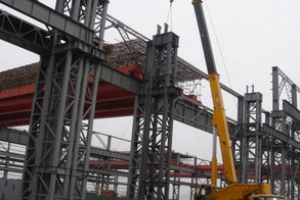钢结构是现代建筑工程中较普通的结构形式之一。钢结构工程安装技术在我国的应用越来越广泛,而且钢结构具备的诸多优越性也被重视,钢结构工程的应用也因此增加。本文通过分析钢结构工程的安装技术要求,从而加强钢结构工程的技术应用和管理,确保整个钢结构工程的安全可靠。
单层门式刚架安装
单跨结构宜从跨端一侧向另一侧、中间向两端或两端向中间的顺序进行吊装。多跨结构,宜先吊主跨、后吊副跨;当有多台起重机共同作业时,也可多跨同时吊装。单层门式刚架钢结构,宜按立柱、连系梁、柱间支撑、吊车梁、屋架、檩条、屋面支撑、屋面板的顺序进行安装。
门式刚架结构安装过程中,需及时安装临时柱间支撑或稳定缆风绳,在形成空间结构稳定体系后方可扩展安装。空间结构稳定体系应能承受结构自重、风荷载、雪荷载、地震作用、安装荷载以及吊装过程中的冲击荷载的作用。
多层、高层钢结构工程安装
(一)多层、高层钢结构工程安装宜划分成多个流水作业段安装,流水段宜以每节框架为单位。流水段划分应符合下列规定:
1)流水段内的比较重构件应在吊装机械的起重能力范围内;
2)起重设备的爬升高度应满足下节流水段内构件的起吊高度;
3)每节流水段内的柱长度应根据工厂加工、运输堆放、现场吊装等因素确定,长度宜取2到3个楼层高度,分节位置宜在梁层标高以上1.0到1.3m处;
4)钢结构流水段的划分应与混凝土结构安装相适应;
5)每节流水段可根据结构特点和现场条件在平面上划分流水区进行安装。
(二)流水作业段内的构件吊装宜符合下列规定:
1)吊装可采用整个流水段内先柱后梁,或局部先柱后梁的顺序;单柱不得长时间处于悬臂状态;
2)钢楼板及压型金属板安装应与构件吊装进度同步;
3)特殊流水段内的吊装顺序应按安装工艺确定,并应符合设计文件的要求。
(三)多层及高层钢结构安装校正应依据基准柱进行,并应符合下列规定:
1)基准柱应能够控制建筑物的平面尺寸并便于其他柱的校正,宜选择角柱为基准柱;
2)钢柱校正宜采用合适的测量仪器和校正工具;
3)基准柱应校正完毕后,再对其他柱进行校正。
(四)多层及髙层钢结构安装时,楼层标高可采用相对标高或设计标髙进行控制,并应符合下列规定:
1)当采用设计标高控制时,应以每节柱为单位进行柱标高调整,并应使每节柱的标高符合设计的要求;
2)建筑物总高度的允许偏差和同一层内各节柱的柱顶高度差,应符合现行标准《钢结构工程安装质量验收规范》GB50205的有关规定。
同水作业段、同一安装高度的一节柱,当各柱的全部构件安装、校正、连接完毕并验收合格后,应在从地面引放上一节柱的定位轴线。高层钢结构安装时应分析竖向压缩变形对结构的影响,并应根据结构特点和影响程度来取预调安装标高、设置后连接构件等相应措施。
(聚氨酯岩棉板,聚氨酯封边岩棉板,金属幕墙岩棉板,金属幕墙板,彩钢岩棉夹芯板,聚氨酯彩钢板,聚氨酯夹芯板,聚氨酯墙面板,聚氨酯屋面板,聚氨酯岩棉夹芯板,聚氨酯玻璃丝棉板,聚氨酯封边岩棉夹芯板,聚氨酯封边玻璃丝棉板,聚氨酯板,聚氨酯PU板。
Steel structure is one of the common structural forms in modern construction engineering. The installation technology of steel structure engineering is more and more widely used in our country, and many advantages of steel structure are also valued, so the application of steel structure engineering is increasing. This paper analyzes the installation technical requirements of steel structure engineering, so as to strengthen the technical application and management of steel structure engineering and ensure the safety and reliability of the whole steel structure engineering.
Installation of single-layer portal frame
The single span structure should be lifted from one side to the other, from the middle to both ends or from both ends to the middle. For multi span structures, the main span should be hoisted first and then the auxiliary span; when there are multiple cranes working together, the multi span can also be hoisted at the same time. The single-layer portal rigid frame steel structure should be installed in the order of column, tie beam, column support, crane beam, roof truss, purlin, roof support and roof panel.
During the installation of portal rigid frame structure, it is necessary to install temporary inter column support or stable cable wind rope in time, and the installation can be expanded only after forming a stable system of spatial structure. The stability system of spatial structure shall be able to bear the self weight of structure, wind load, snow load, earthquake action, installation load and impact load during hoisting.
Installation of Multistory and high-rise steel structure engineering
(1) The installation of multi-layer and high-rise steel structure engineering should be divided into multiple flow operation sections, and the flow section should be based on each frame. The division of flow section shall meet the following requirements:
1) The most reconstructed parts in the flow section shall be within the lifting capacity of the hoisting machinery;
2) The climbing height of the lifting equipment shall meet the lifting height of the internal components of the next flow section;
3) The length of the column in each flow section shall be determined according to factors such as factory processing, transportation and stacking, site hoisting, etc. the length should be 2 to 3 floors high, and the section position should be 1.0 to 1.3m above the beam level;
4) The division of steel structure flow section should be suitable for the installation of concrete structure;
5) Each flow section can be installed by dividing the flow area on the plane according to the structural characteristics and site conditions.
(2) The hoisting of components in the flow operation section should meet the following requirements:
1) The hoisting can be carried out in the sequence of first column and then beam in the whole flow section or first column and then beam in some parts; single column shall not be in cantilever state for a long time;
2) The installation of steel floor and profiled metal plate shall be synchronized with the progress of component hoisting;
3) The hoisting sequence in the special flow section shall be determined according to the installation process and shall meet the requirements of the design documents.
(3) The installation and calibration of multi-layer and high-rise steel structures shall be carried out according to the reference column, and shall meet the following requirements:
1) the datum column shall be able to control the plane dimension of the building and facilitate the correction of other columns, and the corner column shall be selected as the datum column;
2) appropriate measuring instruments and calibration tools should be used for steel column calibration;
3) The reference column shall be calibrated before other columns are calibrated.
(IV) during the installation of multi-layer and high-rise steel structures, the floor elevation can be controlled by relative elevation or design elevation, and shall meet the following requirements:
1) when the design elevation control is adopted, the column elevation shall be adjusted based on each section of column, and the elevation of each section of column shall meet the design requirements;
2) the allowable deviation of the total height of the building and the height difference of the top of each column in the same floor shall comply with the relevant provisions of the current national standard code for acceptance of installation quality of steel structure engineering (gb50205).
For a section of column with the same flow operation section and the same installation height, when all components of each column are installed, calibrated, connected and accepted, the positioning axis of a section of column shall be placed from the ground. During the installation of high-rise steel structure, the influence of vertical compression deformation on the structure shall be analyzed, and the corresponding measures such as adjusting the installation elevation and setting the post connecting members shall be taken according to the structural characteristics and influence degree.
(polyurethane rock wool board, polyurethane edge sealing rock wool board, metal curtain wall rock wool board, metal curtain wall board, color steel rock wool sandwich board, polyurethane color steel plate, polyurethane sandwich board, polyurethane wall panel, polyurethane roof panel, polyurethane rock wool sandwich board, polyurethane glass wool board, polyurethane edge sealing rock wool sandwich board, polyurethane edge sealing glass wool board, polyurethane board, polyurethane PU Board.
 全国免费咨询热线:
全国免费咨询热线:

 全国免费咨询热线:
全国免费咨询热线:

